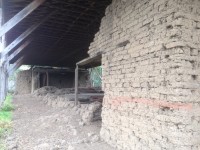Eliza spoke of suffocation from the stench hovering around the stables on a hot summer day. Everyone knew her. She drew sympathy from local Indians, the Mexican elite, soldiers, and American settlers. California was restless in the mid-19th century, as people from all backgrounds rummaged through the west in search of something better, something different, and something to hold on to. Many who spoke with the young girl were just passing through. She was later to recount, “We parted as most people did in those days, feeling that the meeting was good, and the parting might be forever.”
Eliza wasn’t the only Donner party survivor to settle in Sonoma. Her sister Georgia and Lewis Adler also became a part of mid-19th century Sonoma. Even today, while school children may have never heard of significant figures in Sonoma history, the likes of Leese, Poppe, Carriger, Nash or Patton, the Donner Party is still remembered, forever embedded in the brains of those who first hear of their desperate plight in the Sierra Nevada Mountains.
In 1911, Eliza Poor Donner Houghton published “The Expedition of the Donner Party and its Tragic Fate.” While a fascinating glimpse into one of the most remembered tragedies in early American pioneer life, it is the glimpses of Sonoma that captivate my attention. Eliza’s journey to Sonoma began in 1846, where she and her sister Georgia were adopted by Jacob and Marie Bruner in Sutter’s Fort. The Bruners moved to Sonoma in 1847 and built a frame house about 50 feet east of Second Street East and 180 feet south of France Street.
Throughout her memoirs, Eliza illuminates on her keen relationship with nature. One can’t help but wonder if her skills in identifying the flora and fauna of the animal kingdom were engrained in her as a child canvassing across western North America. Eliza speaks of family friend Jakie, who had returned to Sonoma very sick. They were told by the French doctor that Jakie was not responding to the enlightened practices of modern mid-19th century medicine. Eliza and Georgia, equipped with a hoe, knife and basket, walked the two miles to Sonoma Creek in search of nettle. The girls knew that the nettle root steeped in hot water may help cure old Jakie of his ailments.
Eliza wrote “The plants towered luxuriantly above our heads, making the task extremely painful. No sooner would I commence operations that the branches, slipping from under the stick, would brush Georgia’s face and strike my hands and arms with stinging force, and by the time we had secured the required number of roots, we were covered with fiery welts.”
One evening while Grandma Bruner was away, the girls received a visit from John Baptiste who wintered with them in the Sierra. Baptiste was living over the hill in Napa and had heard the girls were living and safe in the town of Sonoma. The girls asked him to get off his horse and rest under the old oak tree. He never dismounted. They offered him a glass of milk, which he declined. Smiling, he removed a small brown-paper bag from his pant pocket. He leaned forward resting his head on the horse’s neck. He watched as Georgia slowly unfolded the package, which held two bunches of raisins, one for each girl.
Eliza writes, “Never had we seen raisins so large, translucent, and delicious. They seemed far too choice for us to have, and John was so poorly dressed and pinched in features that we hesitated about eating them. But he would have his way, and in simple language told us that he wanted them to soften the recollection of the hungry time when he came into camp empty-handed and discouraged. Also to fulfill his assurance to our mother that he would try to keep us in sight, and give us of the best that he could procure.”
Once consumed, he smiled whispering solemnly “Be good little girls; always remember your mother and father; and don’t forget John Baptiste.” The next morning Eliza grabbed the milking pale and headed to the stable before the sun rose to heat the fresh wet cow patties by the adobe barn not far from the house.


Be First to Comment